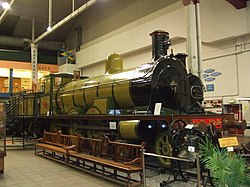Locomotive engineering - a practical journal of railway motive power and rolling stock (1896) (14574550598)
Identifier: locomotiveengine09hill (find matches)
Title: Locomotive engineering : a practical journal of railway motive power and rolling stock
Year: 1892 (1890s)
Authors: Hill, John A. (John Alexander), 1858-1916 Sinclair, Angus, 1841-1919
Subjects: Railroads Locomotives
Publisher: New York : A. Sinclair, J.A. Hill (etc.)
Contributing Library: Carnegie Library of Pittsburgh
Digitizing Sponsor: Lyrasis Members and Sloan Foundation
View Book Page: Book Viewer
About This Book: Catalog Entry
View All Images: All Images From Book
Click here to view book online to see this illustration in context in a browseable online version of this book.
Text Appearing Before Image:
es are substituted for thepunch, and a coupon cut off every sheetand sent to the laboratory. .\s will be seen, this press is a home-made one; the anvil, or die block, is theend of an old driving axle, and the wheelcenter was left on it to form an amplebase. The details of construction will beplain from the engraving. and use a flanging press. Hand-flangingis done, but they use air to hold the hotplate on the former and make it stayput. Our picture shows how this isdone: A long cylinder, fixed by a ball jointto a flat plate, is used to hold down thehot plate while being worked on. Thiscylinder is entirely out of the way of work-men, exposes the entire edge of the platein position to work on, and makes it pos-sible for more men to work at once.When out of use the platen and piston arelifted high enough to give a clear floorspace in the shop, PUNCH OUT OLD ST.\Y-HOI,TS. When a firebox is cut out of an oldshell, it leaves the said shell full of stay-bolt ends screwed in and riveted on the
Text Appearing After Image:
ji):.\\v ri;.\-\VHKi:LKH, for -j-kansco-ntixkntal express, u. p. ry. you through, and consists of an air cyl-inder on the copy press in place of theold screw. It does the work of the largepress well, and much quicker than couldbe done by screw and wheel. AIR ON TRAXSlKR TABLE. By carrying hose on a long, swingingcrane, air is taken to the transfer tableand drives it through the medium of aWestinghouse engine. The table is re-versed by throwing gearing out and in.This requires no attendant, as any me-chanic can stop and start it with ease andsafety. A monstp;r punch. The largest air tool around the place isa monstrous punch, located out of doorsand at the end of the boiler shop. Our illustration will give some idea ofthe size of this tool. The cylinder is 40 BOILER SHF.ET RKCORI). While on the subject, I might as wellmention that a chemical and physicalanalysis is made of a coupon cut fromevery sheet used; the sheet is numbered,and a record book tells just what part ofwhat boiler it be
Note About Images
Relevante Bilder
Relevante Artikel
Ten-WheelerAls Ten-Wheeler werden vor allem im nordamerikanischen Sprachgebrauch Dampflokomotiven mit der Achsfolge 4-6-0 nach der Whyte-Notation, die der deutschen Bauartbezeichnung 2’C entspricht, bezeichnet. Ten-Wheeler besitzen ein vorauslaufendes zweiachsiges Drehgestell und drei gekuppelte Achsen. Ursprünglich vorwiegend als Güterzuglokomotiven und für den Einsatz auf Strecken mit schwierigen Steigungsverhältnissen genutzt, entstanden in dieser Achsfolge im Laufe der Entwicklung eine Vielzahl von Bauarten als Mehrzweck-, Personenzug- und Schnellzuglokomotiven. Die Achsfolge zählt zu den am meisten verbreiteten Achsfolgen im Dampflokomotivbau. Überwiegend wurden Schlepptenderlokomotiven mit dieser Achsfolge gebaut, in geringem Umfang auch Tenderlokomotiven. .. weiterlesen


















